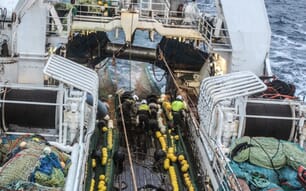The model also provides evidence that egg predation by haddock can cause alternate stable population levels in Georges Bank herring, having significant ecological as well as management implications.
In a study published online on the eight August, 2011 in Proceedings of the National Academy of Sciences (PNAS), researchers from National Oceanic and Atmospheric Administrations (NOAA) Northeast Fisheries Science Center (NEFSC) looked at the role of egg predation by haddock (Melanogrammus aeglefinus) in the decline of the Atlantic herring (Clupea harengus) population off the northeast US.
Atlantic herring spawn eggs that settle and attach to the seafloor. After two to three weeks these eggs hatch and the larvae enter the water column. Haddock feed on a variety of benthic organisms, including sand dollars, brittle stars, and polychaetes or marine worms, but also prey on herring eggs during the herring spawning season.
NEFSC researchers have been monitoring the abundance of larval herring annually since 1971. Historically, changes in larval herring abundance were thought to track changes in adult herring abundance. This study suggests that the mortality rate of herring eggs can vary substantially year to year, with most of that variability driven by haddock preying on herring eggs.
"The premise of our study is that the success of the herring spawning strategy is dependent on overwhelming egg predators, and in particular haddock, said David Richardson, a fishery biologist at the NEFSCs Narragansett, Rhode Island, Laboratory and lead author of the study.
When adult herring are abundant and haddock are at low population levels, a majority of herring eggs hatch, and enough larvae are produced to sustain the herring population at high levels. However, when the herring population is low or the haddock population reaches very high levels, a majority of the herring eggs are consumed before they can hatch into larvae.
The population model they developed, incorporating egg predation by haddock and fishing effort on herring, explains the major population trends of Georges Bank herring over the past four decades. The model predicts that when the haddock population is high, seemingly conservative levels of fishing can still trigger a severe decline in the herring population because of predation on herring eggs by haddock.
There is a threshold herring population size that is dependent on the population size of haddock. When the herring population is pushed below this threshold population size by fishing, it will experience negative population growth until it reaches low levels and at which point it stabilises. When this happens, reducing fishing on herring may not be sufficient to allow for a recovery of the herring population, Mr Richardson said.
Long established in theoretical studies, there has previously been limited evidence that predation-driven alternate stable population levels exist in exploited marine fish populations.
Traditional single-species fishery models assume there is only one equilibrium population size, and that this equilibrium population size is dependent on the level of fishing mortality on that population.
Predictions from this type of model dont agree with the observed trends in Atlantic herring.
Mr Richardson and NEFSC co-authors Jon Hare, Michael Fogarty and Jason Link developed a new population model. They compared the predictions of this model to a compilation of 17 different fisheries-independent time-series for Atlantic herring in the region, including standard bottom trawl and acoustic survey data and food web studies that detail the percentage of herring in the diets of predator fish.
This composite time-series declined from 2005 to 2008, matching the predictions of the population model.
Our model explains how a population can experience decade-scale periods of low productivity and then rapidly switch to a period of high productivity, Mr Richardson said. This study also illustrates how efforts to rebuild fisheries can be undermined by not incorporating ecological interactions into fisheries models and management plans.
The upcoming stock assessment for herring in 2012 will provide a more rigorous and integrated evaluation of the predictions from our model, particularly with respect to the recent trends in Atlantic herring population levels. On the flip-side, our model suggests some future directions for the herring assessment, including the potential for incorporating predation into the assessment model, Mr Richardson said.
Herring Trends Linked To Haddock
US - Scientists have developed a population model for Atlantic herring that links herring population trends to the size of the haddock population.



